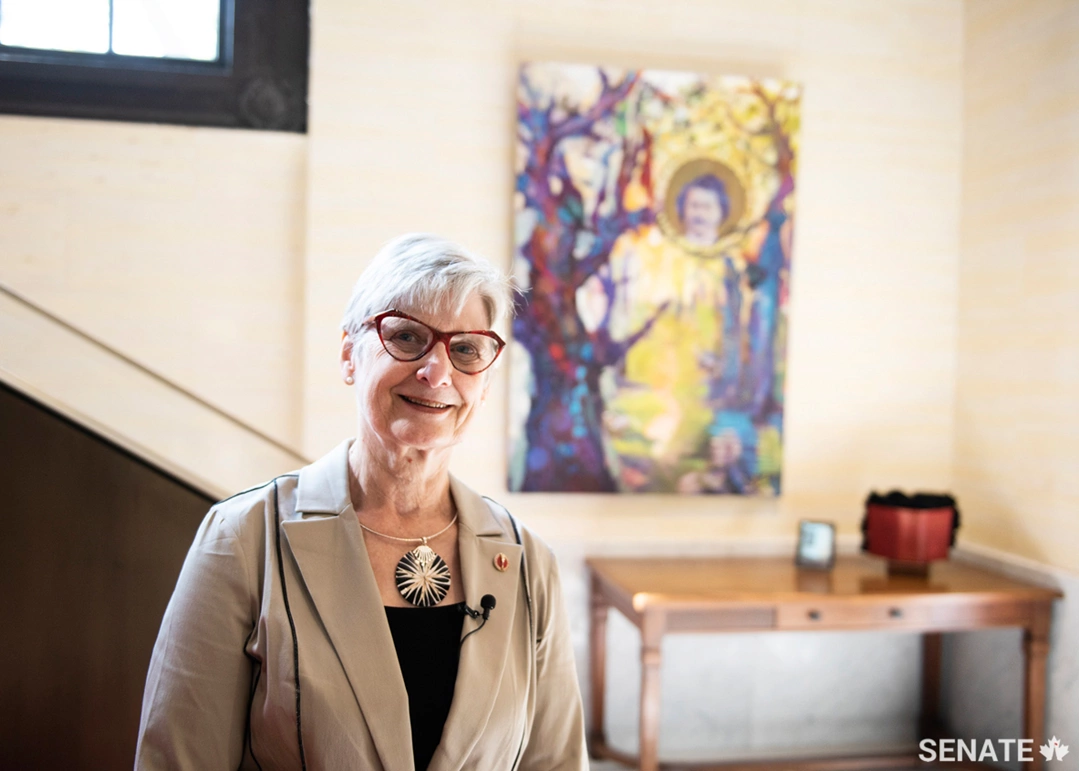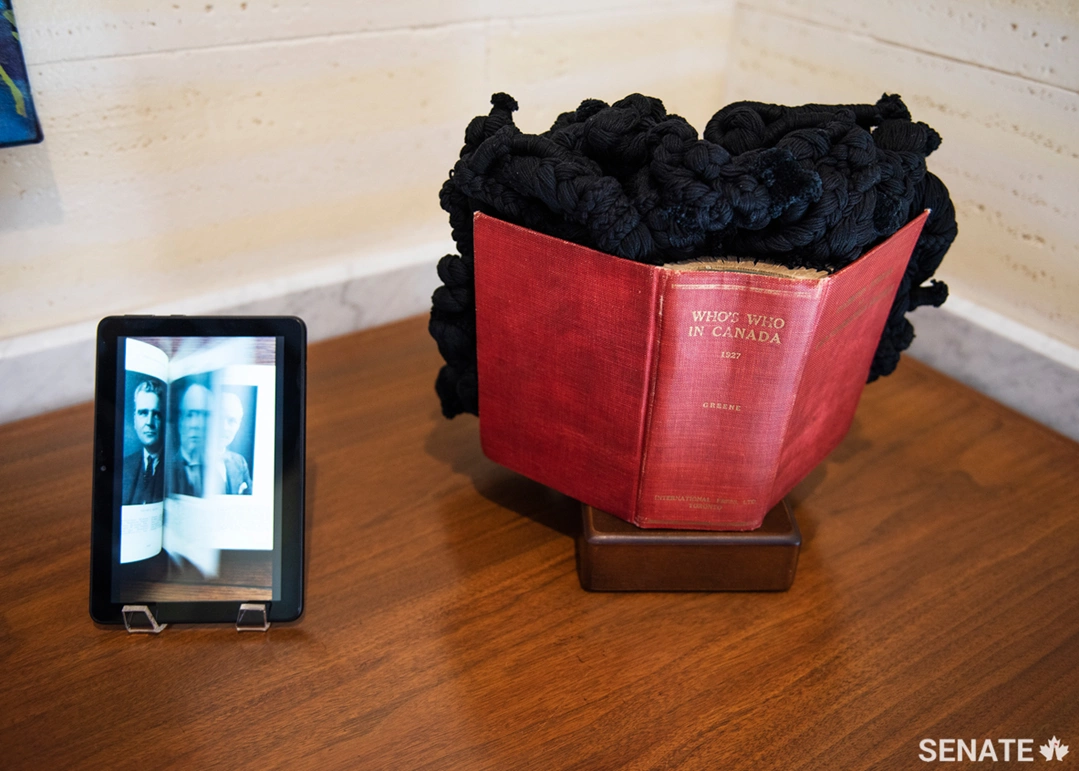SEPTEMBER 21, 2020

Two works by internationally acclaimed Black Canadian artists were installed outside the Red Chamber on September 18, 2020 — the first art display in the Senate arranged specifically to honour Canada’s Black artists.
Stolen Identities, by Winnipeg painter Yisa Akinbolaji, and Who’s Who in Canada 1927 — a mixed-media piece by Vancouver-based artist Chantal Gibson — will be on display for the next nine months.
“One of these artists is looking at the complexity of cultural identities now and one is addressing our systemic writing of Canadian history,” said Senator Patricia Bovey, an art historian and former gallery director who is chair of the Senate’s Artwork and Heritage Advisory Working Group.
The Senate represents Canada’s different regions and culturally diverse communities — representation that should extend to the artwork displayed in its buildings, Senator Bovey said.
“We at the Senate are looking at how we represent Canadians, and this is a positive step. If we’re going to have proper reconciliation, there has to be reconcili-action by everybody.”
The Manitoba senator consulted with and received support from a number of her Black colleagues in launching this project. Stolen Identities and Who’s Who? are on loan until the end of June 2021.
Stolen Identities shows Louis Riel within a Métis dream catcher hanging from Winnipeg trees. The acrylic and oil on canvas fuses the traditional colours and patterns of Mr. Akinbolaji’s native Nigeria with motifs of Indigenous history and reality.
“Stolen Identities is to bring attention to the plight of the Indigenous people of Canada,” Mr. Akinbolaji said. “Their cultural artifacts and historical heroes — like you have on that painting — are celebrated, yet their women and girls have been regularly missing or murdered.”
Who’s Who? is part of Ms. Gibson’s mixed-media series Historical In(ter)ventions, in which she explores the omission of Black voices in Canadian historical texts by altering books with braided and twisted black thread.
Ms. Gibson sculpted Who’s Who? from a 1927 edition of Who’s Who in Canada. A 2020 e-reader is part of the installation and plays a recording of Ms. Gibson flipping through the book’s pages and pictures as they were originally printed.
“Artwork allows us to question power and authority, and it asks the viewer to think about whose voices are included in national narratives and whose are omitted or erased,” Ms. Gibson said.
Senate Curator Tamara Dolan noted the two works have been installed in a “significant space” that otherwise contains only a bust of Queen Elizabeth II and the doors from the original Senate antechamber in Centre Block.
Senator Bovey said she tried to select works that had “tangible hooks” to senators’ and Senate committees’ work. She was a member of the Senate Committee on Foreign Affairs and International Trade when it urged the federal government to increase the use of arts and culture in international diplomacy in a 2019 report.
She hopes the project to honour Black Canadian artists will continue beyond June 2021.

Senator Bovey oversaw the installation of two works by Black Canadian artists in the Senate of Canada Building as part of a new initiative to honour the country’s Black artists.

Senator Patricia Bovey, centre, and Senate Curator Tamara Dolan, right, assist with the installation of Stolen Identities — a painting by Nigerian-Canadian artist Yisa Akinbolaji — in the Senate of Canada Building on Friday, September 18, 2020.

Vancouver-based artist Chantal Gibson’s altered text Who’s Who in Canada 1927 was installed in the Senate of Canada Building on Friday, September 18, 2020. An e-reader displaying a recording of the book’s original pages is part of the installation.
In their own words
‘Shine a bright light’: Yisa Akinbolaji
Yisa Akinbolaji is a visual artist and painter based in Winnipeg, Man.
You came to Canada from Nigeria in 1997, yet you use Métis symbols in Stolen Identities. What drew you to Indigenous culture?
Before I left Nigeria, at times I allowed my creativity to touch on issues surrounding the marginalized. When I arrived here, I began to realize that the Indigenous people have been treated very badly. So as an artist, I think I have an obligation to shine a bright light and document what is missing, so we can work together and make the world a better place for everyone.
Describe the technique you used in Stolen Identities. How long did it take you to create this piece?
That painting took me about three weeks and the medium that I developed and use for my work is Remoglue, which is a certain form of removable glue. The way it works is that I apply a base colour — in most cases, light colours — and then I use that medium to make my sketches, my drawings. After that has dried, I apply [other] colours and I do that as many times as possible depending on the texture or the patterns that I want to create with that technique. The final process is to reveal the effect by peeling off the topmost layer of glue.

Yisa Akinbolaji paints in his Winnipeg, Man. studio on Thursday, September 17, 2020. The painting pictured here, inspired by the Black Lives Matter movement, is a work in progress. (Photo credit: Leif Norman)
What does it mean to you to have this painting displayed in the Senate?
I think the senators are representing the people, so my belief is that their experience of that painting is, in a way, people’s experience of that painting and of the message. I’m pleased and glad that of all the paintings that I have created, the one that speaks to what is missing in our nation here is accepted to be displayed. I strongly believe it’s going to touch their hearts, for them to think not only of the artist but of the message his work presents. I feel that painting should communicate to our respected senators to continue to do what’s right for humanity.
What do you hope Canadians will think about when they study Stolen Identities, either online or in person?
There’s a lot to see from that painting. People who are familiar with Louis Riel will see an honour to that man and, of course, to remember what he represents. As they look in deeply, I believe they will be able to appreciate, from the image and from the title of that work, that we need to improve the way we relate to one another. Let’s hope that in the next 20, 50, 100 years, things will improve. That is part of what I would like that painting to achieve.
Her books talk back: Chantal Gibson
Chantal Gibson is an artist, poet and educator who lives in Vancouver, B.C. and works on the ancestral lands of the Coast Salish People.
What’s the message behind Who’s Who?
That particular book is from 1927; I flipped through it and saw mostly white faces, and mostly white men’s faces. For me, it was the perfect historical artifact to be able to question: Where are the images and voices of Black people? And not just Black people, but Indigenous people, people of colour… where are those voices? Where are the people who look like me? And so, the braided element is imagining those voices speaking or being formed from the silence itself.
Describe the technique(s) you used in Who’s Who?. How long did it take you to create this piece?
The threaded sculpture is made from black mercerized cotton. The material matters. The black colour is rhetorical; the fact that it is cotton is also rhetorical. Black crochet thread is often associated with women’s work.
That book, I think, took a year to make. It required me to punch holes in every single page and then sew and bind the pages into folios. To keep all the thread from tangling, I actually had to use hair clips! I loaded the book with maybe close to 2,000 yards of thread, and then slowly began to tie and wrap that thread and watch the book change form. Depending on what I was thinking about, there are some parts of the sculpture that are very tight, very taut — while other parts remain loose and flimsy.
The way the entire installation works is that it’s a conversation between the past and the present and about old and new ways of thinking.

Chantal Gibson — an artist, poet and educator based in Vancouver, B.C. — speaks at the Museum of Anthropology at the University of British Columbia in February 2020. (Photo credit: Sarah Race)
What does it mean to you to have this piece installed outside the Senate Chamber?
I think Who’s Who? is actually really perfect to be in that building because it is also filled with people who have power and influence. I would hope that the installation is something that’s interesting, that hasn’t been seen before [and] that asks the viewer to stop and contemplate the very space that it’s in.
As senators move past that piece, maybe they might think about my work in conversation with Yisa’s work — and maybe think about why we haven’t seen work by Black artists in this space before. Also, I think that the work is marking a larger shift in the decolonizing conversations that we’re having in this country, and that the inclusion of work by Black artists allows us to interrogate the current moment.
What do you hope Canadians will think about when they study Who’s Who?, either online or in person?
What’s important to me is that people look at a book and they realize that a book is a container of ideas, and our history books come filled with the ideas of the day. And what I prefer to think about with an altered text is: How is that book helping us let go of thinking that is not productive? How does that book get us thinking about power and systemic racism and ideas that might be entrenched in our old books? And how might we repurpose books for the future?
That particular book is from a second-hand store in Vancouver, from a basement, and now it’s in the Senate. So there are new rules for the kinds of old books that used to hold our entire histories — books that used to speak for everybody. And the takeaway is, one book can no longer speak for everyone. My books are kind of talking back.
Source: Senate of Canada

